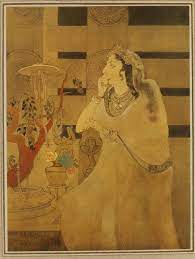Abindranath Tagore rejected European art. Promoted Hindu spirituality to express ‘Indianness’

Belonging to the influential Tagore family of Jorasanko, Calcutta (now Kolkata), Abanindranath Tagore emerged as an artist and writer at a time of great political and cultural upheaval in nineteenth-century India. He is credited with the first formal response to European artistic and aesthetic conventions and values, founding and spearheading the Bengal School — a movement that aimed to reimagine a distinctly Indian approach to visual art. Through his paintings, he rejected European and Academic Realism, promoting instead the ideals of Hindu spirituality and aesthetics to convey an authentic ‘Indianness’.
For the development of this framework, he drew inspiration from the Japanese ink wash technique, a sombre colour palette, and stylistic elements from Mughal, Rajasthani and Pahari miniature painting. In his depictions — which included themes from Hindu mythology, history and Indian rural life — he sought to extract a pan-Indian visual motif and identity. As the Bengal School and his practice were contemporaneous with the Swadeshi movement of the early twentieth century, his work is also interpreted through a nationalist lens. This is perhaps most evident in his painting Bharat Mata (1905), which personified India in the form of a divine Hindu deity and went on to become an enduring symbol of the nation and India’s struggle for independence.
Tagore was homeschooled during his early years, and when his talents became evident, he was sent to study art at Sanskrit College, Calcutta in the 1880s. He began his career as an illustrator, with some of his earliest works appearing alongside the poems of his uncles Rabindranath Tagore and Dwijendranath Tagore in the magazine Sadhana in 1892. In 1890, he enrolled in the Government College of Art and Craft, Calcutta, where he met its principal EB Havell, an Orientalist scholar and pedagogue. Havell had advocated for and secured curricular changes that incorporated the study of Mughal miniatures and emphasised the importance of traditional handicrafts in the syllabi of the fine arts and decorative arts departments, respectively. His search for a unifying image for Indian art that foregrounded tradition over prevalent Indian and Western conventions found resonance in Tagore’s work and outlook. As such, his Modernism emerged as an alternative to that of the Western-influenced painter Raja Ravi Varma, announcing a clear break from the practical, aesthetic and social aspects of colonial art production and distribution.
While Tagore’s status continued to be associated with social and cultural privilege, as was the case with Ravi Varma, he began to challenge the conventions within which his art was produced and consumed. Tagore took strict exception to the academic doctrines of life study, oil painting and Realism. He envisioned an environment where an informed and discerning class of art professionals (such as artists, critics and collectors) would be able to produce and consume art free of the demands of formal training, professional success and livelihood. Havell’s continued support of Tagore — in the form of journal articles introducing his works to a European audience and an exhibition of his paintings in the Government Art Gallery, Calcutta — along with AK Coomaraswamy and Sister Nivedita’s endorsements in the journals of Ramananda Chatterjee, Probashi and The Modern Review, brought him and his cause national and international recognition. Accompanying this increased visibility was the establishment of the Indian Society of Oriental Art, which grew organically out of a series of exhibitions of the members of the Bengal School — and with the aid of a number of influential Calcutta-based European Indophiles — around 1907. The Society, by virtue of being the first art salon in India, provided the ideal platform for the consolidation of the ‘Indianising’ agenda of the Bengal School.
In the early experimental phase of his career, Tagore painted the Krishna Leela series (1895–97) based on Jayadeva’s text Geeta Govinda. Inspired by Kalidasa’s lyric poems Meghaduta and Ritusamhara, he painted The Traveller and The Lotus, The Banished Yaksha and The Siddhas from Upper Air. In these, he attempted in different ways — using composition, tone and technique — to inject elements of Romantic Naturalism into canonical pictorial traditions. Paintings that Tagore made in the Mughal miniature style between 1902 and 1905, which incorporated bhava, were met with great success, winning him awards in the Congress Industrial Exhibition (1902–03) and the Delhi Durbar Exhibition (1911). The most celebrated work from this experiment is Passing of Shah Jahan, where the intricate and material image of the Agra Fort stands in stark contrast to the frail and dying figure of Shah Jahan, who is attended to by his daughter Jahanara. The death of Tagore’s daughter during the plague in Calcutta at the end of the nineteenth century had created an impact on the artist that became apparent in the emotive quality of the series, and of this painting in particular. His iconic Bharat Mata painting was modelled after his daughter and directly reflected this loss.
Tagore is famously credited with introducing and promoting the use of the Japanese ink wash technique, which he learnt from the disciples of Japanese artist Okakura Kakuzo, whom the Tagores hosted at Jorasanko in 1903 and who shared his desire for formulating a pan-Asian aesthetic in opposition to Western Realism. His appointment as vice-principal of the Government College of Art in 1905 also allowed him to incorporate Indian painting into the curriculum. This gave a much-needed boost to traditional Indian art forms and nurtured the emergence of modern Indian artists.
By the 1920s, however, as the influence of the Bengal School decreased, Tagore withdrew from public life and into a more personal practice of painting, illustrating and writing. He resigned from his post at the Government College of Art in 1915, but continued to remain active in academia, delivering a series of twenty-nine lectures on Indian art, aesthetics and philosophy at Calcutta University as the Rani Bageswari Professor of Indian Fine Arts between 1921 and 1929. While these developments took place, Tagore continued his artistic practice, distancing himself from the demands of nationalism and the Swadeshi movement. In this final phase of his career, he painted the Playmate (1925) and Pigeon series (1939–40) — landscape and animal studies that explored themes of talking animals and mythological tales inspired by his childhood stories. His Arabian Nights series (1930) recasts the stories of ancient Baghdad in contemporary urban settings. The Kabikankan and Krishnamangal series (1939) are his last known works.
Tagore’s contribution to art and the evolution of an autonomous identity for modernity in India is bolstered by his legacy of children’s literature and illustration. A prolific writer with a gift for narration, Tagore authored and illustrated several books for children and young adults; notable among them are Raj-Kahini (1916), Sakuntala and Kshiter-Putul (1895–96), Nahush and Buro-Angla. He also wrote several treatises on art, such as Bharat Silpa Sadanga (‘Six Limbs of Painting’) (1921) and Artistic Anatomy (1914). Towards the end of his career, he released a three-part memoir comprising Apan Katha (published as a book only in 1946), Gharoa (1941) and Jorasankor Dhare (1944), the first of which was authored by him and the others by Rani Chanda, to whom he had narrated the stories.
After his death in 1951, his entire collection of paintings was donated to the Rabindra Bharati Society, where they were kept in storage and not displayed publicly. In the last few decades, the paintings from the second phase of his career have been rediscovered by scholars such as KG Subramanyan, Tapati Guha-Thakurta and R Siva Kumar, who have attempted to read his later work outside the nationalist mould he was cast into during his lifetime.
This article is taken from the MAP Academy‘s Encyclopedia of Art with permission.
The MAP Academy is a non-profit, open-access educational platform committed to building equitable resources for the study of art histories from South Asia. Through its freely available digital offerings—Encyclopedia of Art, Online Courses, and Stories—it encourages knowledge building and engagement with the visual arts of the region.
















